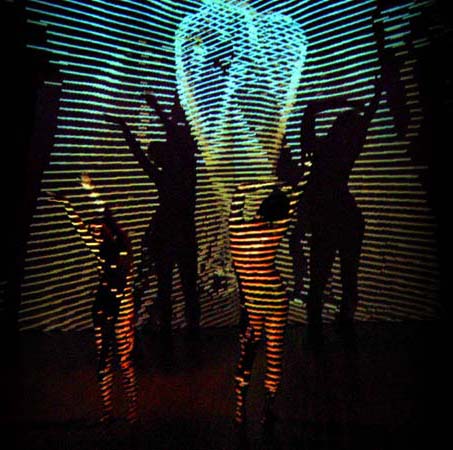In the e-Dance research proposal we opened as follows:
A key problem in the academic field of dance is how to capture and document the incremental development of ideas and their material manifestation in the creative process within practice-led research. In improvisational, embodied investigation, the mode of engagement is generative, pre-verbal, intuitive, experiential and fluid. This militates against types of cognitive engagement necessary for analysis, critique and reflection. The problem is most acute in the context of dance: however it is pertinent to all arts-based disciplines. This project is predicated on dialogic processes between dance and e-Science and the fluidity of concepts as they transverse the two domains, making use of recent advances in the visualisation and representation of spatio-temporal structures and discourse.
Drilling down into the theme of pre-linguistic annotation/capture of choreographic design process, we wrote:
The visual nature of the interface employed by these e-Science documentation tools enables exploration of possibilities for pre-linguistic, multi-layered, non-linear representations of process, more aligned with the characteristics of the creative process itself. This reiteration of process will be considered not just as a static archival document of the process, but as a dynamic source of material that can be redeployed, for example, as a site for forensic, archaeological investigation; a score for further developmental commentaries generated through practice; or pre-recorded audio/visual content for re-use in hybrid distributed performance.
As the Open U. software development effort comes on stream in August, and with our Research Intensive in Bedford only a week or so away, we are now thinking about the kinds of user interface that choreographers want to scaffold, capture, provoke, reflect back their creative process. The role of the visual, and perhaps non-verbal human-computer interaction, are to the fore, as we take seriously the pre-linguistic nature of the choreographic design process. We have learnt from Helen and Sita (our choreographers) and from our partial immersion in the choreographic process, that they will ‘just know’ when they see something ‘right’ unfolding before them on the dance floor: a moment that they want to capture without getting verbal, to be revisited and replayed later for reflection and further rehearsal/research.
With these considerations in mind, it seemed providential when in my email I received an article by Guy Claxton:
Claxton, G. (2006). Thinking at the Edge. Cambridge Journal of Education, Vol. 36, No. 3, pp. 351–362
Claxton, whose work on “building learning power†is influential in the UK education system, has a specific interest in how we teach school pupils what it feels like to learn (not always pleasant — “what to do when you don’t know what to doâ€) — so is of interest to me with other hats in at the Open U. and as a school governor. But this article tries to put language and concepts on how we conceive, and nurture, creativity in general. As I wrote about elsewhere, his interest is in how we work with, not fear or fight, that creative period when things remain inchoate, ill-formed and unsettling:
…there is a softer, slower kind of groping for a way of articulating something that is currently, tantalizingly, beyond our linguistic grasp… It is these gentle, generic, but often unsung, aspects of the creative process that I want to describe.
Intruigingly he uses the particular example of choreographers, as he writes about:
…the intuitive feeling of rightness (or wrongness) that guides the process. This sense of rightness—the same immediate, unjustifiable feeling of ‘Yes, that’s it’ that guides the process of focusing—seems to be essential to the kind of creativity I am exploring. A choreographer may not know what it is she is looking for until she tries out one more move and gets the ‘Yes, that’s it’ response. As I write, I too do not know quite what I want to say, nor precisely where the discussion is heading, until a sentence hits the screen and I get the ‘Yes, that’s it’ feeling. Even research scientists must learn to recognize and trust that intuition.
Inspired by the 1960s work of Eugene Gendlin at the University of Chicago on the pre-conceptual period of creativity and cognitive change, and continued by his associates [Focusing Institute], Claxton writes:
Gendlin’s point is this: that the kind of personal problem-solving that happens in counseling and psychotherapy usually requires slow, delicate, hazy knowing, rather than quick, conceptual, conscious knowing. The main problem is often not one of ‘deciding what to do’, but of coming to understand more precisely what it is that makes things appear problematic to us in the particular way they do. And that kind of knowing requires us to be able to go ‘back to basics’; to start with the complicated, murky ‘felt sense’ of the predicament, and then slow down the process of epistemic evolution so we can (a) see more clearly what kinds of assumptions we might, unconsciously, have been stirring in to the conceptual mix; and (b) allow the emerging conceptualization to be driven, and continually refined, by the felt sense itself, rather than forcing it to fit the pre-existing templates, categories, habits and phrases that we happen to have installed in the skill-scape and the word-scape. Focusing enables people to regain some flexibility, with regard to their ‘ways of knowing’. In particular, it helps them relearn the kind of patient, open-minded attentiveness that allows them to conceptualize their predicament in a way that is fresher, more differentiated, and more accurate, in the sense of being closer to the complex reality of their own embodied knowing.
So, all this is quite intruiging. Embodied, pre-verbal cognition looks to be an interesting seam to mine in the coming months as we seek to build language that bridges cognitive interface design and dance, and concretely, to adapt our visual hypermedia tools (Compendium and Cohere) to support the construction of resources for choreographic, practice-based research.





